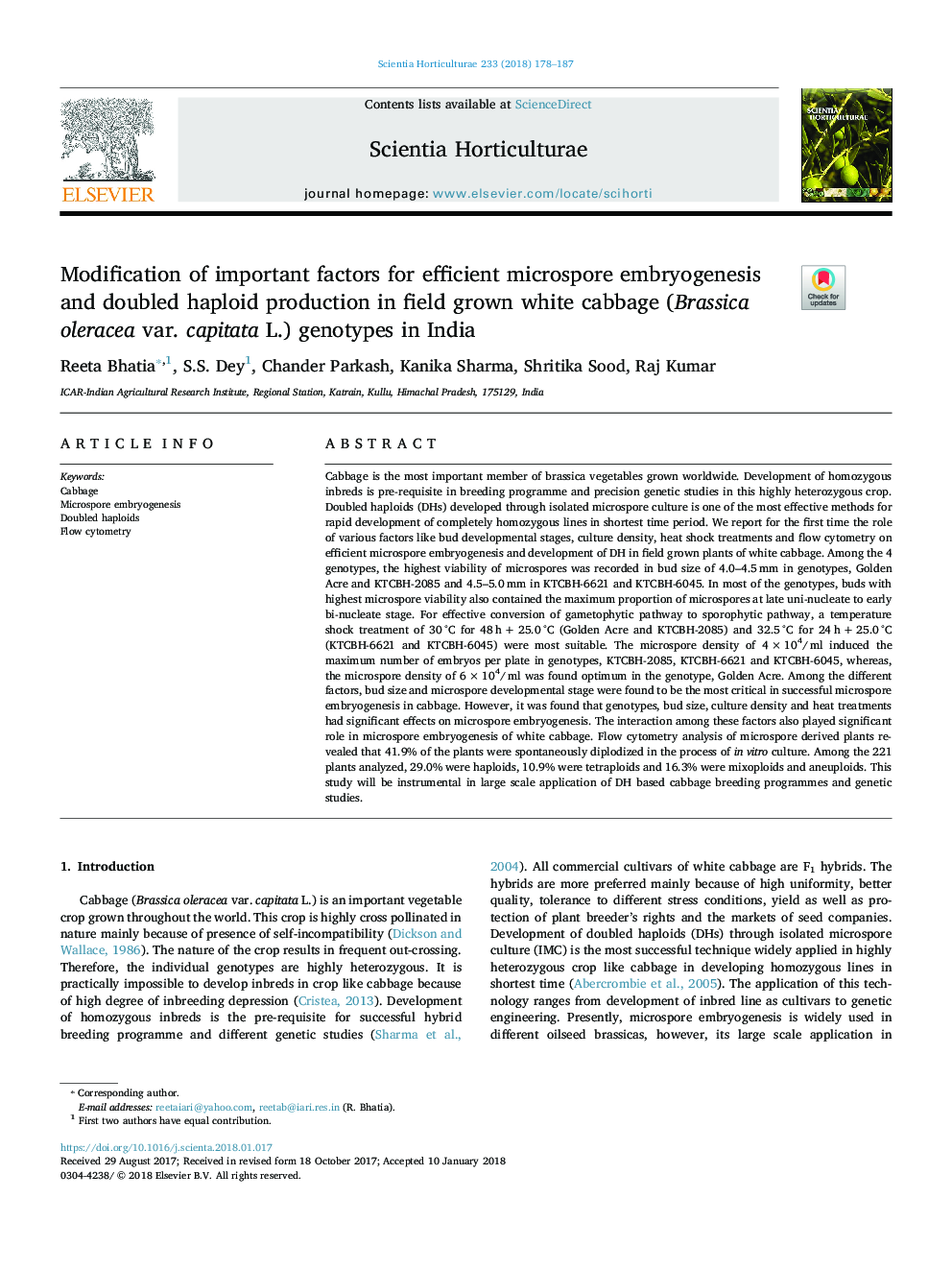| کد مقاله | کد نشریه | سال انتشار | مقاله انگلیسی | نسخه تمام متن |
|---|---|---|---|---|
| 8892856 | 1628765 | 2018 | 10 صفحه PDF | دانلود رایگان |
عنوان انگلیسی مقاله ISI
Modification of important factors for efficient microspore embryogenesis and doubled haploid production in field grown white cabbage (Brassica oleracea var. capitata L.) genotypes in India
دانلود مقاله + سفارش ترجمه
دانلود مقاله ISI انگلیسی
رایگان برای ایرانیان
موضوعات مرتبط
علوم زیستی و بیوفناوری
علوم کشاورزی و بیولوژیک
دانش باغداری
پیش نمایش صفحه اول مقاله

چکیده انگلیسی
Cabbage is the most important member of brassica vegetables grown worldwide. Development of homozygous inbreds is pre-requisite in breeding programme and precision genetic studies in this highly heterozygous crop. Doubled haploids (DHs) developed through isolated microspore culture is one of the most effective methods for rapid development of completely homozygous lines in shortest time period. We report for the first time the role of various factors like bud developmental stages, culture density, heat shock treatments and flow cytometry on efficient microspore embryogenesis and development of DH in field grown plants of white cabbage. Among the 4 genotypes, the highest viability of microspores was recorded in bud size of 4.0-4.5â¯mm in genotypes, Golden Acre and KTCBH-2085 and 4.5-5.0â¯mm in KTCBH-6621 and KTCBH-6045. In most of the genotypes, buds with highest microspore viability also contained the maximum proportion of microspores at late uni-nucleate to early bi-nucleate stage. For effective conversion of gametophytic pathway to sporophytic pathway, a temperature shock treatment of 30â¯Â°C for 48â¯hâ¯+â¯25.0â¯Â°C (Golden Acre and KTCBH-2085) and 32.5â¯Â°C for 24â¯hâ¯+â¯25.0â¯Â°C (KTCBH-6621 and KTCBH-6045) were most suitable. The microspore density of 4â¯Ãâ¯104/â¯ml induced the maximum number of embryos per plate in genotypes, KTCBH-2085, KTCBH-6621 and KTCBH-6045, whereas, the microspore density of 6â¯Ãâ¯104/â¯ml was found optimum in the genotype, Golden Acre. Among the different factors, bud size and microspore developmental stage were found to be the most critical in successful microspore embryogenesis in cabbage. However, it was found that genotypes, bud size, culture density and heat treatments had significant effects on microspore embryogenesis. The interaction among these factors also played significant role in microspore embryogenesis of white cabbage. Flow cytometry analysis of microspore derived plants revealed that 41.9% of the plants were spontaneously diplodized in the process of in vitro culture. Among the 221 plants analyzed, 29.0% were haploids, 10.9% were tetraploids and 16.3% were mixoploids and aneuploids. This study will be instrumental in large scale application of DH based cabbage breeding programmes and genetic studies.
ناشر
Database: Elsevier - ScienceDirect (ساینس دایرکت)
Journal: Scientia Horticulturae - Volume 233, 15 March 2018, Pages 178-187
Journal: Scientia Horticulturae - Volume 233, 15 March 2018, Pages 178-187
نویسندگان
Reeta Bhatia, S.S. Dey, Chander Parkash, Kanika Sharma, Shritika Sood, Raj Kumar,